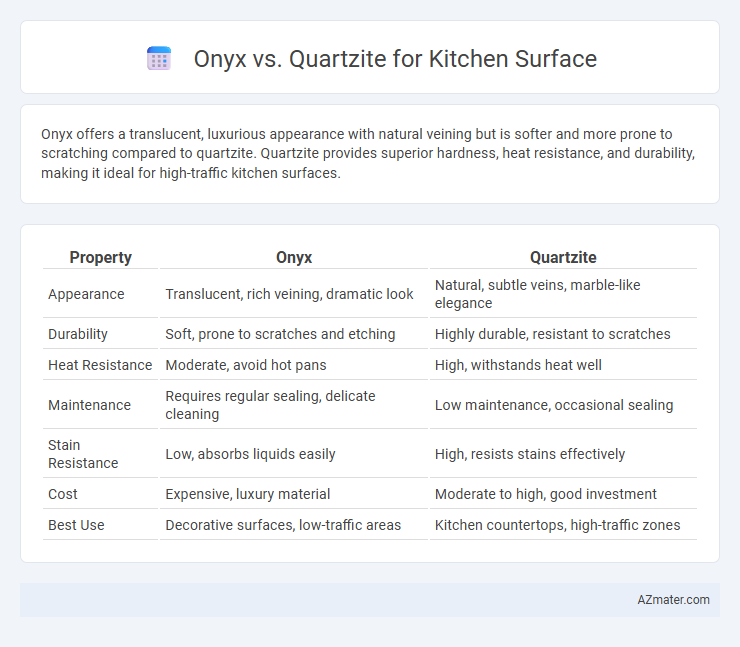Onyx offers a translucent, luxurious appearance with natural veining but is softer and more prone to scratching compared to quartzite. Quartzite provides superior hardness, heat resistance, and durability, making it ideal for high-traffic kitchen surfaces.
Table of Comparison
| Property | Onyx | Quartzite |
|---|---|---|
| Appearance | Translucent, rich veining, dramatic look | Natural, subtle veins, marble-like elegance |
| Durability | Soft, prone to scratches and etching | Highly durable, resistant to scratches |
| Heat Resistance | Moderate, avoid hot pans | High, withstands heat well |
| Maintenance | Requires regular sealing, delicate cleaning | Low maintenance, occasional sealing |
| Stain Resistance | Low, absorbs liquids easily | High, resists stains effectively |
| Cost | Expensive, luxury material | Moderate to high, good investment |
| Best Use | Decorative surfaces, low-traffic areas | Kitchen countertops, high-traffic zones |
Comparing Onyx and Quartzite: An Introduction
Onyx and quartzite are premium natural stones used for kitchen surfaces, each offering distinct properties suited for different design needs. Onyx is valued for its translucency and luxurious appearance, often backlit to enhance its glowing patterns, but it is softer and more prone to scratches and etching compared to quartzite. Quartzite, formed from sandstone under intense heat and pressure, provides exceptional durability and resistance to heat, making it ideal for high-traffic kitchen areas demanding long-lasting stone surfaces.
Visual Appeal: Onyx vs Quartzite Aesthetics
Onyx offers a luxurious, translucent appearance with rich, swirling patterns and vibrant colors that create a dramatic focal point in kitchen surfaces. Quartzite provides a natural stone look with subtle veining and a more consistent, matte finish, appealing to those seeking elegance with durability. The choice between onyx and quartzite depends on whether a bold, luminous statement or a classic, timeless aesthetic is desired.
Material Durability: Strength and Longevity
Onyx offers a unique, translucent appearance but is softer and more prone to scratching and etching compared to quartzite, which ranks higher in hardness and resists wear and tear better. Quartzite's natural durability and resistance to heat, stains, and impacts make it ideal for high-traffic kitchen surfaces requiring long-term strength. Choosing quartzite ensures a robust countertop that maintains its structural integrity and aesthetic appeal in intensive kitchen environments.
Maintenance Requirements and Care Differences
Onyx kitchen surfaces require more delicate maintenance due to their softness and porosity, necessitating gentle cleaning with pH-neutral, non-abrasive products and regular sealing to prevent staining and etching. Quartzite, being harder and more durable, withstands daily wear with less frequent sealing and can tolerate mild abrasive cleansers, making it easier to maintain in a busy kitchen environment. Both stones demand avoidance of harsh chemicals and immediate spill cleanup, but quartzite offers greater resilience and long-term ease of care compared to the more sensitive onyx.
Stain and Scratch Resistance Comparison
Quartzite offers superior stain and scratch resistance compared to onyx, making it a more durable choice for kitchen surfaces. Onyx's softer composition is prone to etching and scratches from daily kitchen use, requiring more maintenance and careful handling. Quartzite's hardness and non-porous nature provide better protection against common kitchen stains and abrasions, ensuring long-lasting beauty and functionality.
Heat Tolerance: Performance in the Kitchen
Quartzite exhibits superior heat tolerance among natural stones, withstanding temperatures up to 1,200degF without damage, making it ideal for kitchen surfaces exposed to hot pots and pans. Onyx, being softer and more porous, is sensitive to heat and prone to cracking or discoloration when exposed to high temperatures, requiring careful use of trivets and heat protectors. The durability and heat resistance of quartzite ensure long-lasting performance in demanding kitchen environments.
Cost Analysis: Budget Considerations
Quartzite is generally more affordable than onyx, with prices ranging from $60 to $100 per square foot compared to onyx's $100 to $250 per square foot. Maintenance costs for onyx are higher due to its softer, more porous nature requiring frequent sealing and careful handling. Budget-conscious homeowners often opt for quartzite to balance durability and aesthetic appeal without incurring the premium cost associated with onyx surfaces.
Installation Process and Complexity
Onyx kitchen surfaces require meticulous installation due to their delicate, translucent nature, often necessitating specialized adhesives and backlighting considerations to enhance their visual appeal. Quartzite, being a harder, more durable natural stone, offers a more straightforward installation process with standard stone fabrication techniques, but its density demands heavy-duty cutting equipment and precise handling to avoid chipping. Professional installers recommend thorough site preparation and custom measuring for both materials to ensure a perfect fit and longevity in high-traffic kitchen environments.
Environmental Impact and Sustainability
Onyx is a natural stone known for its translucent beauty but requires intensive mining processes that can lead to significant environmental disruption and higher carbon emissions compared to quartzite. Quartzite, formed from sandstone under high pressure and heat, tends to have a lower environmental footprint due to more abundant availability and less energy-intensive extraction methods. Choosing quartzite for kitchen surfaces supports sustainability through its durability, reducing the need for frequent replacement and minimizing long-term resource consumption.
Choosing the Best Surface: Key Factors to Consider
Onyx offers a luxurious, translucent appearance with unique veining, ideal for decorative kitchen surfaces but requires careful maintenance due to its softness and susceptibility to scratching. Quartzite provides superior durability and heat resistance, making it a practical choice for high-traffic kitchen countertops that endure daily wear and tear. Consider factors like hardness, stain resistance, maintenance requirements, and aesthetic preferences when choosing between onyx and quartzite for your kitchen surface.

Infographic: Onyx vs Quartzite for Kitchen Surface
 azmater.com
azmater.com